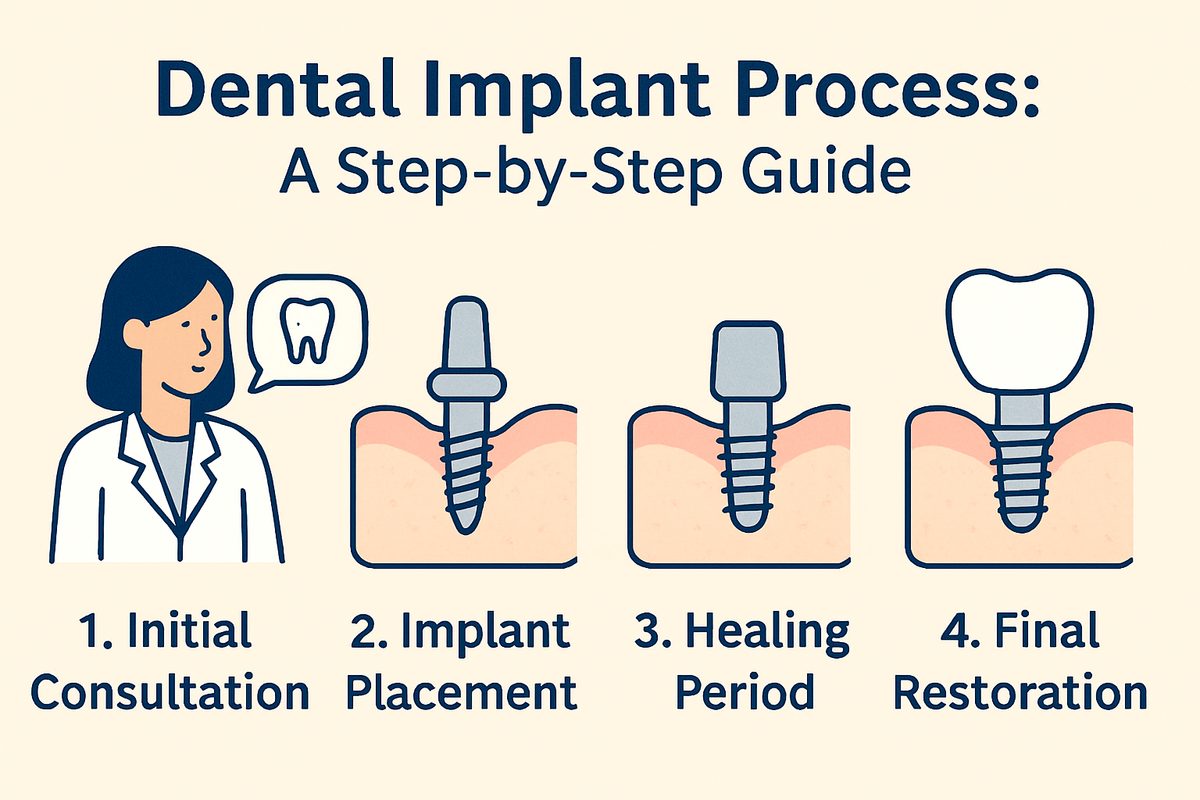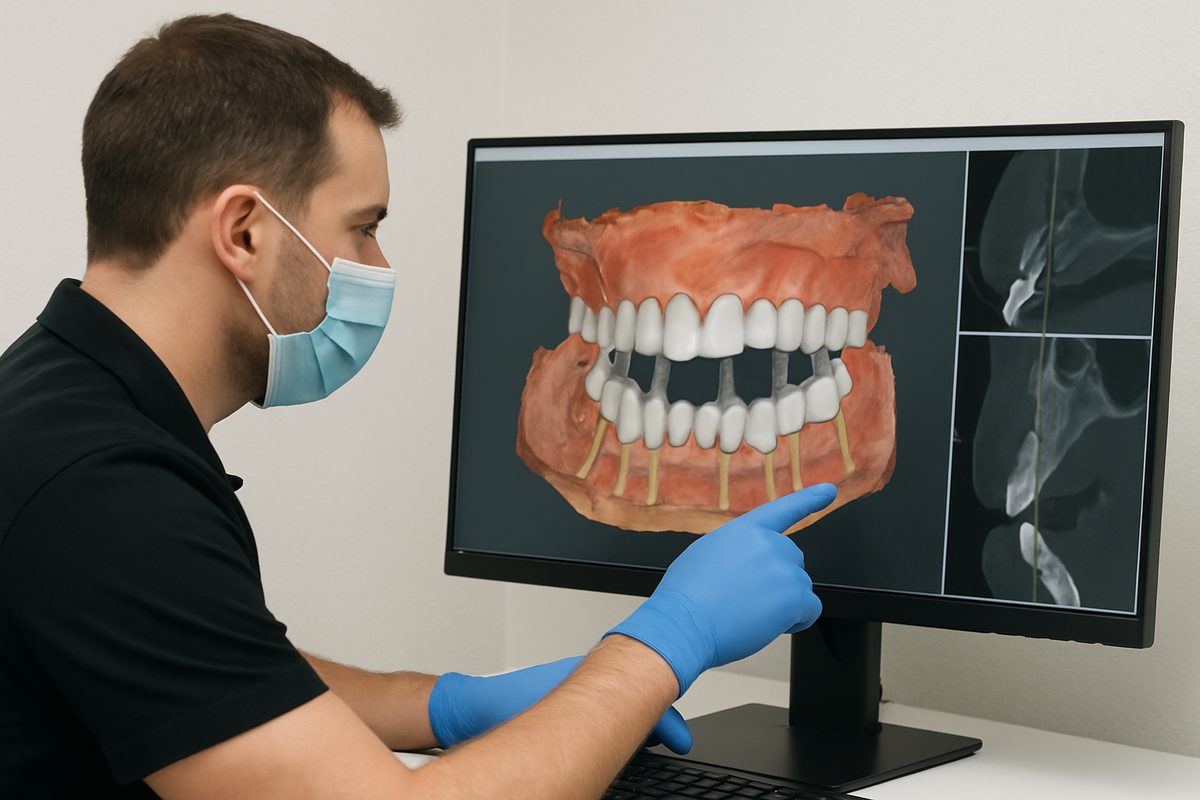Blog - [City], [state]
Tips, Facts, And The
Latest In Dentistry

Your 2024 Guide To The Dental Implant Process Step By Step
Posted in Dental Implants

This guide is for anyone thinking about dental implants. Read on to learn the dental implant process step by step in Tulsa so you know what to expect from your first consult to the final crown. This clear, patient-friendly guide explains each stage, common questions, and how to move forward with treatment.
What Is a Dental Implant? Simple definition and benefits
A dental implant is a small titanium post placed into the jawbone to replace a missing tooth root. A crown, bridge, or denture attaches to the implant to restore the tooth. Benefits include a natural look, normal chewing, and bone preservation. Implants are designed to be a long-term solution that feels and functions like real teeth.
Who Is a Good Candidate?
Good candidates are in generally good health, have adequate jawbone, and are committed to oral hygiene. Signs you might need implants include one or more missing teeth, loose dentures, or discomfort from gaps. If bone is low or medical issues exist, alternatives like bridges or dentures may be safer until concerns are managed.
The Dental Implant Process Step By Step: Overview
This high-level list shows the main stages of the dental implant process step by step in Tulsa: – Consultation and treatment planning – Imaging and digital planning (CBCT) – Preparatory treatments (extractions, grafts) – Implant placement surgery – Healing and osseointegration – Abutment and impression – Final restoration and adjustments – Aftercare and maintenance
Step 1: Consultation and Treatment Planning
At your first visit the dentist will review your medical and dental history, discuss goals, and do an exam. Expect questions about medications, health conditions, and what you want from treatment. The dentist will outline options, timelines, and rough cost estimates so you leave with a clear plan.
Step 2: Imaging and Digital Planning
CBCT 3D scans and digital X-rays show bone shape, nerve positions, and sinus height. Digital planning lets the team place implants precisely on a computer before surgery. Better imaging means higher success and fewer surprises during treatment.
Step 3: Preparatory Treatments (if needed)
Some patients need tooth extractions, bone grafts, or sinus lifts before implants. These procedures build a stable base for the implant. They add time—often several months—to the overall plan but improve long-term outcomes.
Step 4: Implant Placement Surgery
On surgery day you’ll get local anesthesia, sedation, or general anesthesia depending on the case. The dentist places the titanium implant into the bone and covers it with a healing cap. The procedure is usually well tolerated. Expect mild swelling or soreness for a few days and clear post-op instructions.
Step 5: Healing & Osseointegration
Osseointegration is when bone grows around the implant to lock it in place. This takes 3–6 months for most patients. You should follow diet and oral hygiene limits during healing. Normal signs include light discomfort and minor swelling; persistent pain, fever, or unusual drainage should prompt a call to the office.
Step 6: Abutment & Impression (Getting Ready for the Crown)
Once the implant is stable, the dentist attaches an abutment that links the implant to the crown. The team takes a digital or physical impression to design the final crown. You may get a temporary crown while the lab makes the permanent one.
Step 7: Final Restoration and Bite Adjustment
The final crown or bridge is attached and checked for fit, color, and bite. The dentist adjusts the occlusion to ensure comfortable chewing and even force distribution. A well-made restoration should look natural and function like a real tooth.
Aftercare, Maintenance, and Long-Term Success
Care for implants like natural teeth: brush twice, floss daily, and see your dentist for regular cleanings. Avoid hard habits (chewing ice, opening packages). Regular checkups help catch issues early. With good care, implants can last decades; maintenance is key to long-term success.
Costs, Financing, and Insurance Considerations
Costs vary by case complexity, the number of implants, and need for grafting. Financing plans and third-party dental loans can spread payments. Most medical and dental plans have limited coverage for implants—confirm details with your insurer. Expect clear cost breakdowns during treatment planning.
Common Questions Patients Ask About the Dental Implant Process Step By Step
– Does it hurt? Most patients report mild to moderate discomfort that eases in a few days with pain meds. – How long does it take? Typical timelines range from 3 to 9 months, depending on extra treatments. – Is there an age limit? Healthy adults of most ages can get implants; bone health matters more than age. – What are success rates? Implants have high success rates—often over 95% with good care. – How long will they last? With proper care, implants can last many years or a lifetime.
Why Consider Dental Arts of Oklahoma for Your Implants
Dental Arts of Oklahoma delivers implant care across Catoosa, Tulsa, Bixby, Locust Grove, and Nowata. The practice uses CBCT imaging, digital planning, and All-on-4® protocols for predictable results. Dr. Soren Michaelsen leads a team focused on comfort, modern technology, and long-term outcomes. If you want advanced tools and a patient-first approach, this team provides full-scope care under one roof.
Next Steps: How to Get a Consultation
Bring your medical history, current medications, and any recent X-rays. Call or request an appointment online to start your personalized plan. During the consult you’ll get a clear estimate, timeline, and answers to your questions about the dental implant process step by step in Tulsa. Scheduling a visit is the best next step toward a stable, natural-looking smile.




